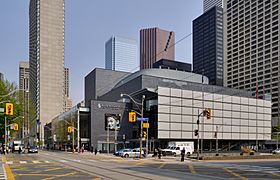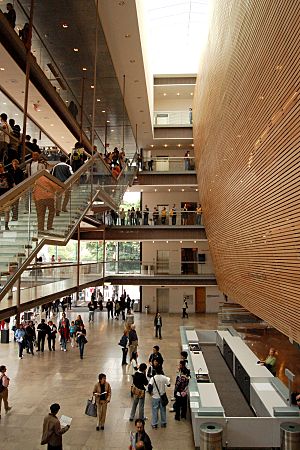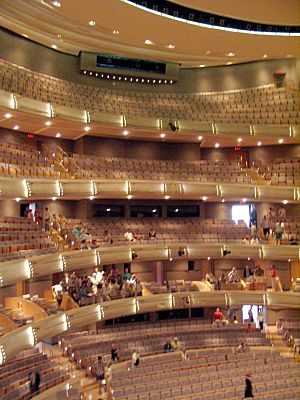Four Seasons Centre facts for kids

Four Seasons Centre seen from University Avenue with sun shades covering its glazed facade
|
|
| Address | 145 Queen Street West Toronto, Ontario M5H 4G1 |
|---|---|
| Coordinates | 43°39′02″N 79°23′08″W / 43.65056°N 79.38556°W |
| Owner | Canadian Opera House Corporation |
| Type | Opera house |
| Capacity | 2,071 |
| Construction | |
| Opened | 14 June 2006 |
| Architect | Diamond+Schmitt |
| Tenants | |
| Canadian Opera Company National Ballet of Canada |
|
The Four Seasons Centre for the Performing Arts is a large theatre in Toronto, Ontario, Canada. It has 2,071 seats and is located in downtown Toronto. This special building is the home for two famous Canadian groups: the Canadian Opera Company (COC) and the National Ballet of Canada.
The building has a cool, modern design. It was created by a Canadian company called Diamond Schmitt Architects. The main architect was Jack Diamond. The centre was finished in 2006. Inside, you can see an amazing glass staircase!
Contents
History of the Centre
For many years, people wanted a new home for opera and ballet in Toronto. In the 1980s, the Canadian Opera Company and a person named Hal Jackman started working to get a new building. The opera company had been performing in the O'Keefe Centre for about 40 years. Before that, they performed in other theatres like the Royal Alexandra Theatre.
First Idea: Bay Street
In 1984, the leader of Ontario, Bill Davis, said that a piece of land would be given for a new opera house. This land was located at Bay Street and Wellesley Street. It was worth a lot of money, about $75 million.
A design competition was held, and a project by Moshe Safdie was chosen. In 1988, the plan was approved. Old stores and offices on the land were torn down to make space.
However, a new government came into power in 1990. They faced a big money problem because of a recession. The new opera house project was going to cost $311 million, which was seen as too much. The government also had to deal with the high cost of the SkyDome project. Because of these money issues, the government stopped funding the opera house project. In 1992, the project was cancelled. The land was later sold to developers. Some buildings called "Opera Place I and II" were built there. The Teahouse Condo was completed on the rest of the property in 2020.
Second Idea: University Avenue
In 1997, the government offered a different piece of land for the project. This land was a parking lot at Queen and University. It was worth $31 million. Both the Canadian and Ontario governments also promised money for a new, smaller project. This new plan would cost about $130 million.
However, some of the main supporters and donors had concerns and pulled out. Also, the city of Toronto did not want to give any money. So, the project stopped again in 2000.
In 2002, the opera company, led by Richard Bradshaw, asked for new designs. They had received a big donation of $20 million from the Four Seasons hotel chain. In return, the building would be named the Four Seasons Centre forever. Ten architecture companies showed their ideas. The modern design by Diamond Schmitt Architects was chosen.
The building took three years to build and cost about $181 million. It was designed to be easy for everyone to use. For example, there is an elevator that connects the centre directly to the Osgoode subway station. The Four Seasons Centre officially opened on June 14, 2006. Regular shows started on September 12, 2006. The first big show was Richard Wagner's opera Der Ring des Nibelungen. Many important Canadians, including Governor General Michaëlle Jean, attended the opening.
R. Fraser Elliott Hall Design
The main performance hall is called the R. Fraser Elliott Hall. It has five levels of seating and is shaped like a horseshoe, similar to old European opera houses. The design team worked hard to make sure all 2,000 seats have a great view of the stage.
The sound in the hall is amazing! Special walls help spread the sound evenly. To keep out noise from outside, like traffic or the subway, the entire theatre sits on 489 special rubber pads. These pads stop vibrations from reaching the audience.
Outside the Building
The Four Seasons Centre was built with a careful budget. It uses different materials that create a nice contrast. The front of the building, called the City Room, has large glass walls. These walls let light in and look out onto University Avenue and Queen Street. The other sides of the building are covered in dark brick.
The architect, Jack Diamond, explained that he wanted the building to fit in with the city. He said, "You do not make a city out of iconic pieces." This means he wanted it to be a part of Toronto, not just a standalone fancy building.
Richard Bradshaw Amphitheatre
Inside the City Room, there is a smaller area called the Richard Bradshaw Amphitheatre. It can seat about 100 people. During the performance season, many free concerts are held here each week. You can hear different kinds of music in this space.
Past Performances
The Four Seasons Centre has hosted many famous operas and musicals. The Canadian Opera Company has performed many classic and new operas here. Some of the important operas include:
- 2006: R. Wagner: Der Ring des Nibelungen (This was the first time this opera was performed in Canada!)
- 2007: Shostakovich: Lady Macbeth of Mtsensk
- 2008: Janáček: From the House of the Dead
- 2010: Donizetti: Maria Stuarda
- 2012: Kaija Saariaho: Love from Afar
- 2018: Rufus Wainwright: Hadrian
Musicals have also been performed at the Four Seasons Centre. Some popular ones include:
- 2010: Schönberg/Boublil/Maltby Jr: Miss Saigon
- 2010: Rodgers/Hammerstein: South Pacific
- 2011: Tom Kitt/Brian Yorkey: Next to Normal
Other Places to See Shows
Toronto has many other great places to watch performances. Some of them are:
- Budweiser Stage
- Massey Hall
- Meridian Arts Centre
- Meridian Hall
- Roy Thomson Hall
See also
 In Spanish: Four Seasons Centre para niños
In Spanish: Four Seasons Centre para niños



